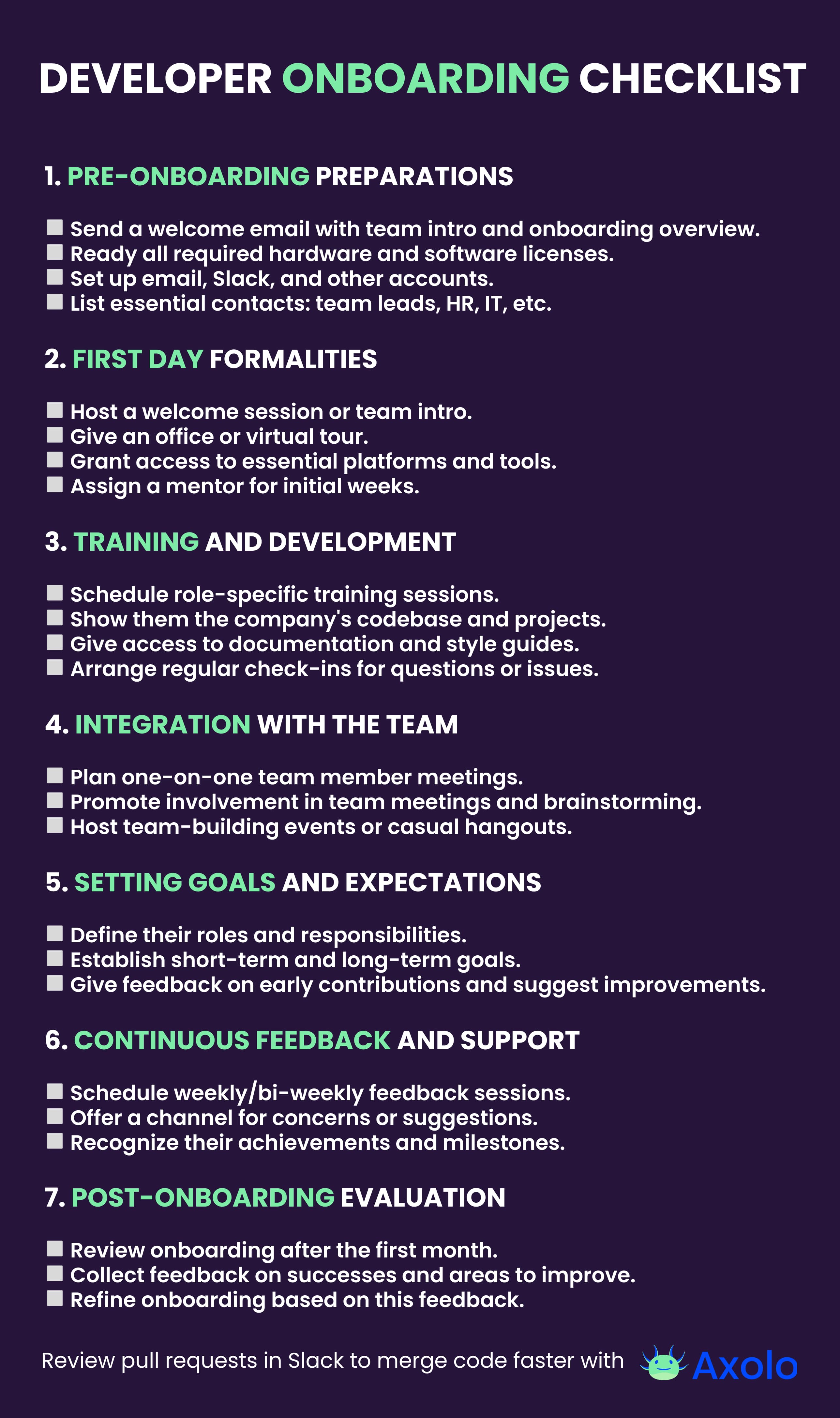- Published on Tuesday, August 22, 2023, last updated
Improving Developer Onboarding: Best Practices and Checklist for 2023
Welcome to the world of developer onboarding! Remember the first day at a new job? The mix of excitement and the slight nervousness of diving into unfamiliar territory? It's a feeling many developers know all too well. But onboarding shouldn't feel like navigating a maze without a map. It's about ensuring every new developer feels equipped, confident, and ready to contribute from the get-go.
In this guide, we'll explore the best practices to improve developer onboarding in 2023 with some best practices. Ready to level up your onboarding game?
Table of Contents
- Why is Developer Onboarding Crucial?
- 1. Retention Rates
- 2. Productivity
- 3. Team Cohesion
- Best Practices for Onboarding Developers
- 1. Tailored Training Programs
- 2. Providing the Right Tools and Resources
- 3. Setting Clear Expectations and Goals
- Tools and Technologies for Effective Developer Onboarding
- 1. Overview of Popular Onboarding Tools
- 2. Benefits of Using Specialized Tools:
- TL;DR: A Comprehensive Developer Onboarding Checklist
- 1. Pre-Onboarding Preparations
- 2. First Day Formalities
- 3. Training and Development
- 4. Integration with the Team
- 5. Setting Goals and Expectations
- 6. Continuous Feedback and Support
- 7. Post-Onboarding Evaluation
- Challenges in Developer Onboarding and How to Overcome Them
- 1. Overwhelming Information Overload
- 2. Lack of Personalization:
- 3. Inadequate Tools and Resources:
- 4. Unclear Expectations:
- 5. Isolation from the Team:
- Conclusion
- Developer Onboarding Checklist Shareable Image
Why is Developer Onboarding Crucial?

Thank you Steve for such a great onboarding with so many useless graphs!
Ah, the age-old question: Why spend time and resources on a fancy onboarding process? Can't developers just, you know, dive in and figure things out? Well, as tempting as that might sound, there are some rock-solid reasons to invest in a structured onboarding process. Let's break it down:
1. Retention Rates
First impressions matter, and the onboarding process is a company's first real chance to impress a new developer. A smooth, well-thought-out onboarding experience can make a developer feel valued and understood, increasing the likelihood they'll stick around for the long haul. On the flip side, a hasty or confusing onboarding can leave a sour taste, leading to higher turnover rates. And let's be real, hiring is expensive! Retaining talent is not just good for morale; it's good for the wallet.
2. Productivity
Imagine trying to bake a cake without a recipe. Sure, you might end up with something edible, but it's going to take a lot longer and might not taste as sweet. The same goes for developer onboarding. Providing clear guidelines, resources, and training from the start ensures that new developers can hit the ground running. They spend less time figuring out the basics and more time doing what they do best: coding and innovating.
3. Team Cohesion
Every team has its own rhythm, its own set of inside jokes, and its unique way of collaborating. A structured onboarding process introduces new developers to the team's culture and dynamics. This fosters a sense of belonging and ensures that everyone is on the same page. When developers feel integrated and aligned with the team's goals and values, collaboration becomes smoother, and the team's overall synergy gets a boost.
In a nutshell, developer onboarding isn't just a fancy term or a box to tick off. It's the foundation for building strong teams, driving productivity, and ensuring that talent sticks around to make magic happen. So, the next time someone asks, "Why bother with onboarding?", you'll have a few solid answers up your sleeve!
Jean-Baptiste Aviat, CTO at Sqreen (acquired by Datadog), shares his experience on how to onboard developers.
Best Practices for Onboarding Developers
So, we've established that developer onboarding is a big deal. But how do you actually make it work? Fear not, dear reader, for we've got the lowdown on the best practices to ensure your new developers feel like they've hit the jackpot from day one.
1. Tailored Training Programs
One size doesn't fit all, especially when it comes to training. Developers come with diverse backgrounds, experiences, and skill sets. While some might be wizards in Python, others might be venturing into it for the first time. Creating tailored training programs allows you to address individual needs and knowledge gaps. This not only speeds up the learning process but also ensures that every developer feels seen and supported.
2. Providing the Right Tools and Resources
Imagine being handed a spoon to chop vegetables. Sounds frustrating, right? Equipping developers with the right tools and resources is crucial. This means access to the necessary software, platforms, and documentation from the get-go. A well-stocked developer toolkit can make the difference between a smooth onboarding and a frustrating slog. And hey, don't forget about mentorship! Pairing newbies with seasoned pros can be a game-changer, offering hands-on guidance and insights that no manual can provide.
3. Setting Clear Expectations and Goals
Navigating a new job without clear directions is like setting sail without a compass. From the outset, it's essential to set clear expectations regarding roles, responsibilities, and performance metrics. This provides a roadmap for new developers, helping them understand where they fit in and what's expected of them. Regular check-ins and feedback sessions can further ensure that they're on the right track and feel confident in their journey.
In conclusion, onboarding developers is an art and a science. It's about understanding their needs, equipping them with the right tools, and guiding them towards success. With these best practices in your arsenal, you're well on your way to creating an onboarding experience that's nothing short of stellar!

Don't be like him
Tools and Technologies for Effective Developer Onboarding
Alright, let's get techy! While passion and a great team spirit are essential, they're not the only ingredients for a successful onboarding process. Enter the world of onboarding tools and technologies. These digital buddies can make the transition for new developers smoother than a freshly debugged code. Let's dive in!
1. Overview of Popular Onboarding Tools
- Trello or Jira: These project management tools are fantastic for setting tasks, tracking progress, and ensuring that new developers have a clear roadmap from day one.
- Slack: Communication is key, and Slack channels dedicated to onboarding can provide new developers with a space to ask questions, share insights, and connect with their peers. You can also find here a list of .
- Axolo: If your team is using Slack, you should try ! It's a collaboration app for developers to help them review pull requests faster and enhance their internal communication.
- GitHub or Bitbucket: For version control and collaborative coding, these platforms are a must-have. They allow new developers to familiarize themselves with ongoing projects and dive into the codebase.
- Confluence or Notion: Documentation is a developer's best friend. Platforms like Confluence or Notion offer a space to store, update, and access essential documents, guides, and tutorials.
- Loom or Zoom: For virtual training sessions, screen recordings, or just a good old face-to-face chat, tools like Loom or Zoom come in handy, especially in today's remote-working era.
If you're interested in more tools dedicated for engineering teams, I highly recommend my last article on !
Axolo User Experiences
2480+ developers online

2. Benefits of Using Specialized Tools:
- Efficiency: Specialized onboarding tools streamline the process, reducing the time it takes for a developer to become a fully-fledged member of the team.
- Consistency: With structured tools, every developer goes through a standardized process, ensuring that no crucial steps are missed and everyone gets the same quality experience.
- Engagement: Interactive tools make the onboarding process more engaging, turning what could be a mundane process into an interactive and enjoyable experience.
- Feedback and Tracking: Many onboarding tools come with analytics and feedback mechanisms, allowing team leads to monitor progress and make necessary adjustments in real-time.
- Collaboration: These tools foster collaboration, allowing new developers to easily connect with their teammates, ask questions, and share insights.
In the digital age, leveraging the right tools and technologies is not just a luxury; it's a necessity. By integrating these into your onboarding process, you're setting your developers—and your company—up for success.
TL;DR: A Comprehensive Developer Onboarding Checklist
Every great journey begins with a single step, and for a developer, that journey is the onboarding process. To make sure no stone is left unturned and every step is as smooth as possible, we've crafted a comprehensive checklist for you. Think of it as your trusty roadmap to developer onboarding success! If you're intested in using this checklist right away, you can find it in a markdown format on our GitHub repository or as a shareable image at the end of the article!
1. Pre-Onboarding Preparations
- Send a welcome email introducing the team and providing a brief overview of the onboarding process.
- Ensure all necessary hardware (laptops, monitors, etc.) and software licenses are ready.
- Set up their email, Slack, and other communication accounts.
- Prepare a list of contacts they might need: team leads, HR, IT support, etc.
2. First Day Formalities
- Conduct a warm welcome session or team introduction.
- Provide a tour of the office (or a virtual tour if working remotely).
- Ensure they have access to all necessary platforms and tools.
- Assign a mentor or buddy for the first few weeks.
3. Training and Development
- Schedule initial training sessions tailored to their role and skills.
- Introduce them to the company's codebase and current projects.
- Provide access to documentation, style guides, and best practices.
- Organize regular check-ins to address any questions or challenges.
4. Integration with the Team
- Schedule one-on-one meetings with team members to foster connections.
- Encourage participation in team meetings and brainstorming sessions.
- Organize team-building activities or casual hangouts.
5. Setting Goals and Expectations
- Clearly outline their roles and responsibilities.
- Set short-term and long-term goals.
- Provide feedback on their initial contributions and guide them on improvements.
6. Continuous Feedback and Support
- Organize weekly or bi-weekly feedback sessions.
- Ensure they have a platform or channel to voice any concerns or suggestions.
- Celebrate their achievements and milestones, no matter how small.
7. Post-Onboarding Evaluation
- Conduct a review after the first month to assess the onboarding process.
- Gather feedback on what went well and areas of improvement.
- Use this feedback to refine the onboarding process for future developers.
Remember, onboarding is more than just a series of tasks; it's the beginning of a relationship between the developer and the company. By following this checklist, you're not just ticking off boxes; you're building a foundation for success, collaboration, and growth.
Challenges in Developer Onboarding and How to Overcome Them
Onboarding developers isn't always a walk in the park. Like any process, it comes with its own set of challenges. But fear not! For every pitfall, there's a solution waiting to be discovered. Let's delve into some common challenges and how to tackle them head-on.
1. Overwhelming Information Overload
- Pitfall: Bombarding new developers with too much information too soon can leave them feeling lost and overwhelmed.
- Solution: Break down the onboarding process into manageable chunks. Use a phased approach, introducing information gradually and ensuring there's ample time for understanding and assimilation.
2. Lack of Personalization:
- Pitfall: Treating all developers the same, regardless of their background and experience, can lead to disengagement.
- Solution: Tailor the onboarding process based on the developer's experience and skill set. Personalized training sessions and mentorship can make a world of difference.
3. Inadequate Tools and Resources:
- Pitfall: Not providing the necessary tools and platforms can hinder a developer's ability to integrate and contribute effectively.
- Solution: Ensure all essential software, platforms, and documentation are readily available from day one. Regularly update and refine the toolset based on feedback.
4. Unclear Expectations:
- Pitfall: Without clear guidelines and objectives, developers can feel directionless, leading to decreased motivation and productivity.
- Solution: Set clear, achievable goals for the onboarding period. Regular check-ins and feedback sessions can help align expectations and provide clarity.
5. Isolation from the Team:
- Pitfall: If new developers don't feel integrated with the team, it can lead to feelings of isolation and reduced team cohesion.
- Solution: Foster team interactions from the start. Organize team-building activities, encourage participation in team meetings, and assign a buddy or mentor to guide them.
Onboarding challenges, while common, are not insurmountable. With a proactive approach, keen observation, and a dash of empathy, you can create an onboarding experience that's both effective and enjoyable for every developer that walks through your doors (or logs in remotely!).
Conclusion
Onboarding developers is more than just a series of tasks or a checklist to tick off. It's the first chapter in a developer's journey with your organization—a chapter that sets the tone for the rest of their tenure. By understanding the importance of this process, recognizing its challenges, and implementing best practices, organizations can ensure that every developer feels valued, equipped, and ready to contribute from day one.
In the fast-paced world of tech, where innovation is the name of the game, a smooth onboarding process can be the difference between a developer who merely does their job and one who truly thrives. So, invest the time, resources, and heart into your onboarding process. After all, today's new recruit is tomorrow's tech superstar. Here's to building strong foundations and fostering lasting relationships. Happy onboarding!
If you liked this article, you can discover even more tips and best practices on our dedicated !
Axolo is a Slack app to help techteams review pull request seamlessly
Developer Onboarding Checklist Shareable Image
